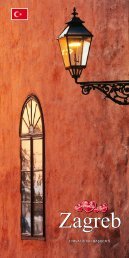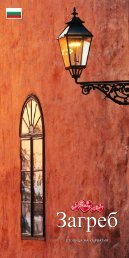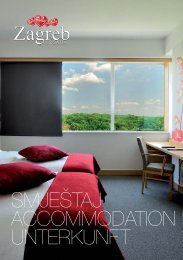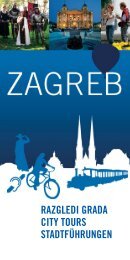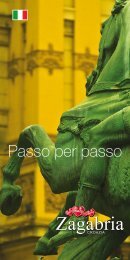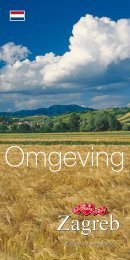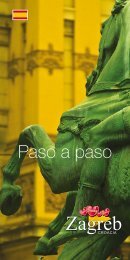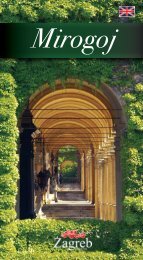to zagreb 08 - Zagreb tourist info
to zagreb 08 - Zagreb tourist info
to zagreb 08 - Zagreb tourist info
- No tags were found...
You also want an ePaper? Increase the reach of your titles
YUMPU automatically turns print PDFs into web optimized ePapers that Google loves.
Here&Nowike Paris, the Croatian capitalgives you the impression thatL nobody is working. Locals relaxon café terraces, lovers stroll theshaded grounds of Ribnjak behindthe twin-<strong>to</strong>wered Cathedral whileshoppers browse the market stallsbrimming with the fresh produceof southern Europe. Shaped byHabsburg rule, <strong>Zagreb</strong> exudes aMediterreanean way of life, withfringes of Balkan excess wherenightlife is concerned. The city’s onlymust-see is the Cathedral, with thearguable exception of the MimaraMuseum, so sightseeing duties arelight. You can ride the funicularlinking the Upper (Gornji Grad) andLower (Donji Grad) Towns, takein bizarre sights (the TechnicalMuseum is recommended), whileaway an hour in the MaksimirPark or Mirogoj cemetery – orjoin the locals, lovers and browsersdoing whatever they’re doing.Laid out according <strong>to</strong> Habsburgdesign, with a ‘horseshoe’ of greenspace separating its elegant façades,<strong>Zagreb</strong> is surprisingly small for acapital of one million people. Anecclesiastical and political hub frommedieval times, <strong>Zagreb</strong> was ruledfrom Vienna, Budapest and Belgradebefore gaining capital-city status inthe 1990s. Since then, the cityhas been replacing its Ti<strong>to</strong>-erashopfronts with chic boutiques, andthrowing up malls wherever it canfind the space. Walk along any gridpatternedstreet of the Lower Townand you might come across a bar orshop changed little since the 1970s orbefore. These are now the exceptions– <strong>Zagreb</strong> may be gaining modernitybut it’s losing its charm.Bans and battlesSet by Mount Medvednica, <strong>Zagreb</strong>grew up on the north bank of theSava. It comprised two rival hill<strong>to</strong>psettlements, Gradec and Kap<strong>to</strong>l,site of <strong>to</strong>day’s Sabor, the CroatianParliament, and the Cathedral.Kap<strong>to</strong>l and Gradec fought forcenturies. Proof is in the naming ofKrvavi most, Bloody Bridge, thealley at the end of Skalinska andscene of battles between them.By the 17th century, with theGovernor (Ban) of Croatia andthe Sabor based here, <strong>Zagreb</strong>’simportance overshadowed the localrivalry. By the 19th, its developmentreflected a growing search fora Croatian identity. Prestigiousbuildings centrepieced a neat spreadof grid-patterned streets and squaresbetween the Upper Town of Kap<strong>to</strong>land Gradec, and the train station.Habsburg in appearance, it gainedthe name of Lower Town. A mainsquare, Harmica, was laid out wherethe Upper and Lower Towns met.Power still rested in the twinHabsburg capitals of Vienna andBudapest. In 1848, the Croatian Ban,Josip Jela±i©, led an army in<strong>to</strong>Hungary. His bid failed but he washonoured with a statue on Harmica,mounted on his horse, his swordpointed in defiance.After World War II, Yugoslavleader Ti<strong>to</strong> had the statue removedand the square named Trg republike.Across the river Sava, he built rows ofhousing blocks, Novi (‘New’) <strong>Zagreb</strong>,site of new developments such as aMuseum of Contemporary Artdue <strong>to</strong> open by the end of 20<strong>08</strong>. AfterCroatian independence, the Jela±i©statue was reassembled and thesquare renamed Trg bana JosipaJela±i©a. This is still the mainsquare <strong>to</strong>day, along which pass thecity’s trams all through the day.Everything is an easy hop fromhere, invariably walking, or byjumping on a passing tram for a fews<strong>to</strong>ps. You can take a break at one ofthe many comfortable coffeehouseslining the square. Take your time –that’s what all the locals do.TIME OUT <strong>Zagreb</strong> 15



